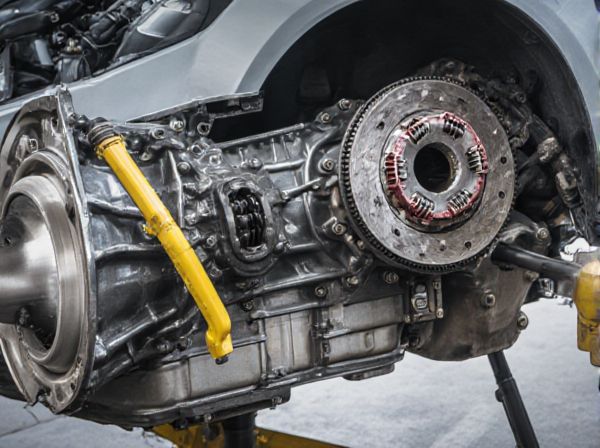
Photo illustration: Wet clutch vs Dry clutch
Wet clutches operate submerged in oil, providing smoother engagement and better heat dissipation for improved durability in high-performance or heavy-duty applications. Dry clutches function without oil, offering more direct power transfer and lighter weight, making them ideal for racing or motorcycles where quick response is crucial. Your choice depends on whether you prioritize longevity and smoothness (wet clutch) or efficiency and responsiveness (dry clutch).
Table of Comparison
| Feature | Wet Clutch | Dry Clutch |
|---|---|---|
| Operation | Uses oil for cooling and lubrication | Operates without oil, air-cooled |
| Heat Dissipation | Better heat dissipation due to oil | Lower heat dissipation, prone to overheating |
| Durability | Higher durability, less wear | More wear, shorter lifespan |
| Efficiency | Lower mechanical efficiency due to oil drag | Higher mechanical efficiency |
| Maintenance | Requires oil changes and monitoring | Less maintenance required |
| Cost | Generally more expensive | Typically less costly |
| Common Usage | Used in motorcycles, high-performance cars | Found in lightweight vehicles, racing cars |
Introduction to Wet and Dry Clutches
Wet clutches operate submerged in lubricating oil, providing smoother engagement and dissipating heat efficiently, making them ideal for motorcycles and automatic transmissions. Dry clutches function without oil, offering direct power transfer and higher friction but tend to wear faster and generate more heat, commonly used in manual transmissions and performance vehicles. Both clutch types serve critical roles in power transmission systems, balancing durability and performance based on application demands.
How Wet Clutches Work
Wet clutches operate by submerging friction plates in oil, which cools and lubricates the clutch components, preventing overheating during engagement and disengagement. The oil bath reduces wear and extends the clutch's lifespan by minimizing friction-induced damage. This design enables smoother power transfer and improved durability in motorcycles, automatic transmissions, and heavy machinery.
How Dry Clutches Operate
Dry clutches operate by engaging and disengaging friction plates that are not immersed in lubricating oil, allowing for a direct and efficient transfer of power between the engine and transmission. The absence of oil reduces slippage and heat dissipation, resulting in quicker response times and higher torque capacity, especially in high-performance motorcycles and racing cars. These clutches require precise material engineering and ventilation to handle increased frictional heat and ensure durability during operation.
Key Differences Between Wet and Dry Clutches
Wet clutches operate immersed in oil, offering superior cooling and smoother engagement, which enhances durability and reduces wear under high-load conditions. Dry clutches function without lubrication, enabling a more direct power transfer and generally lighter weight but are prone to faster wear and elevated heat buildup. The choice between wet and dry clutches depends on application-specific requirements such as thermal management, performance, and maintenance frequency.
Performance Comparison: Wet vs Dry Clutch
Wet clutches offer superior heat dissipation and smoother engagement due to their oil bath lubrication, enhancing durability and performance under high-stress conditions. Dry clutches provide more direct power transfer with less drag, resulting in quicker response and improved fuel efficiency but tend to wear faster and generate more heat. Performance optimization depends on application demands, with wet clutches favored in motorcycles and heavy vehicles for longevity, while dry clutches are preferred in sports cars for faster shifting and weight savings.
Maintenance and Longevity
Wet clutches require regular oil changes and inspections to maintain optimal performance, as the oil helps dissipate heat and reduce wear, extending their lifespan significantly. Dry clutches, though simpler in design, tend to wear out faster due to higher operating temperatures and require more frequent replacement of friction plates. Proper maintenance of wet clutch systems, including using manufacturer-recommended lubricants, ensures longer durability compared to dry clutches, which are more susceptible to heat-related deterioration.
Typical Applications: Industries and Vehicles
Wet clutches are predominantly used in motorcycles, ATVs, and automotive transmissions where heat dissipation and smooth engagement are critical, especially in high-performance and off-road vehicles. Dry clutches find typical applications in racing cars, light motorcycles, and manual transmissions of passenger vehicles, favored for their simplicity, lighter weight, and direct power transfer. Industries such as automotive manufacturing, motorsports, and heavy machinery favor wet clutches for durability, while dry clutches are preferred in applications requiring quick response and minimal maintenance.
Pros and Cons of Wet Clutches
Wet clutches offer superior cooling and durability due to their constant lubrication with oil, which reduces friction and enhances heat dissipation during operation. They provide smoother engagement and are highly effective in high-performance or heavy-duty vehicles, but the oil bath increases energy loss and decreases overall mechanical efficiency compared to dry clutches. Maintenance is more complex because of oil contamination and potential leaks, leading to higher servicing costs and more frequent replacements of clutch components.
Pros and Cons of Dry Clutches
Dry clutches offer advantages such as reduced complexity, lower maintenance costs, and improved power transfer efficiency due to the absence of oil, making them ideal for high-performance motorcycles and racing applications. However, dry clutches tend to generate more heat and noise, require more frequent adjustments, and suffer from faster wear compared to wet clutches, which are lubricated by oil to enhance durability and smooth operation. The choice between dry and wet clutches depends on balancing performance needs against comfort and longevity in specific vehicle applications.
Choosing the Right Clutch: Factors to Consider
Choosing the right clutch involves assessing factors like heat dissipation, maintenance frequency, and intended use; wet clutches offer superior cooling and durability in high-performance or stop-and-go conditions, while dry clutches provide a more direct power transfer with less drag suited for lightweight applications. Vehicle type, driving style, and environmental conditions also influence the clutch choice, as wet clutches excel in motorcycles and heavy machinery, whereas dry clutches are preferred in racing or lightweight vehicles. Evaluating torque requirements, cost implications, and longevity helps optimize performance and ensure reliability in specific operational contexts.
 caratoz.com
caratoz.com